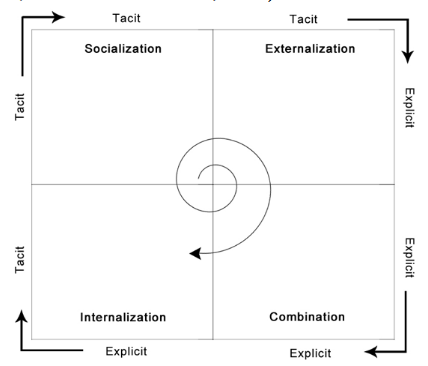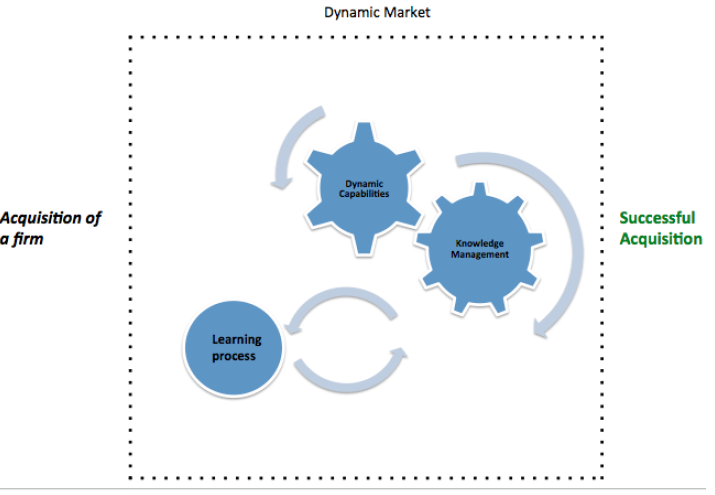ABSTRACT
Problem Statement
How do the learning processes affect firms within the manufacturing industry to overcome challenges in acquisitions?
Purpose
The purpose of this study is to investigate how the learning processes affect managers in the manufacturing industry to be able to reconfigure their bundle of resources and manage the knowledge in and between the acquired company and the parent company to overcome challenges in the acquisition process.
Theoretical Framework
The theoretical framework is based on two main concepts which are dynamic capabilities and knowledge management. At the end of this chapter, the authors have created a conceptual model linking the concepts together with an emphasis on the learning processes.
Methodology
To be able to fulfill the purpose of this thesis, a qualitative approach was chosen where four interviews were conducted with managers in two manufacturing companies that have entered new markets recently through acquisition.
Findings and Conclusion
The conclusion of the study shows that all of the concepts are essential when making an acquisition within the manufacturing industry. The study showed that the learning is an essential element in the acquisition cases since companies need to learn and gain knowledge in order for them to handle the newly acquired resources and to benefit from the synergies that can arise. It was also found that the knowledge creation is an ongoing process with no closure which over time creates deeper and more powerful knowledge that can lead to competitive advantages.
THEORETICAL FRAMEWORK

Figure 2.1 The SECI Model (Nonaka 1991;1994; Nonaka & Konno, 1998; Nonaka et al., 2000; Nonaka & Toyama, 2003)
The model of SECI that is illustrated in figure 2.1 (The SECI Model, p. 23) shows the continuous process of the conversion between tacit and explicit knowledge (Inkpen, 1998; Nonaka et al., 2009). The concept of ba is a component from the SECI process in which knowledge is shared, created and utilized in “shared” places (Inkpen, 1998; Nonaka & Takeuchi, 1995; Nonaka et al., 2009). Even though each phase in the SECI model can create knowledge independently, the knowledge creation processes in the organization can only occur when all the phases are managed and interacted dynamically (Haslinda & Sarinah, 2009; Nonaka & Takeuchi, 1995).

Figure 2.3 Own Processing.
The knowledge creation can be seen as a dynamic and interactive process in which knowledge is synthesized from the interaction between individuals/organization and environment (Mehrabani & Shajari, 2012; Nonaka & Toyama, 2003; Nonaka et al., 2009; Van Gils & Zwart, 2004). Both the interaction with the environment and the actions taken by the organization is what create and develop knowledge through the converting process of tacit and explicit knowledge as illustrated in figure 2.2 (Mehrabani & Shajari, 2012; Nonaka & Toyama, 2003; Nonaka et al., 2009).
METHODOLOGY
In this chapter the approach of the study will be presented followed by an explanation of how the primary and secondary data have been collected. The ethical issues and the trustworthiness of the paper will be finally discussed.
- Research approach
- Research strategy
- Research method
- Data collection
- Selection
- Operationalization
- Data analysis
- Trustworthiness
- Ethical issues
EMPIRICAL DATA
In this chapter the two companies that will be used as empirical data will be presented follow by a brief presentation of the respondents. One of the companies is a Swedish SME operating in the manufacturing while the other is a multinational company operating in the manufacturing industry. Furthermore, the empirical data will be presented. The presentation of data will follow the same structure as the theoretical framework and parts that the authors’ find of importance is highlighted as quotations. This chapter will be the basis for the upcoming analysis.
ANALYSIS

Figure 2.1 ( The SECI Model, p.23).
The interaction process, which characterize the knowledge creation and development, occurs through a converting process of tacit and explicit knowledge as illustrated in Figure 2.1 ( The SECI Model, Nonaka 1991;1994; Nonaka & Konno, 1998; Nonaka et al., 2000; Nonaka & Toyama, 2003) and explained further in figure 2.2 ( Knowledge creation table, Nonaka & Konno, 1998; Nonaka et al, 2000). The four different phases in this process of knowledge creation is characterized by different activities that wi ll in the end of cycle lead to new, deeper and more powerful knowledge in t he organization (Nonaka, 1991).
CONCLUSION
The purpose of the study was to investigate how the learning processes affects managers in the manufacturing industry to be able to reconfigure their bundle of resources and manage the knowledge in and between the acquired company and the Mother company to overcome challenges in the acquisition process. This was done by studying the concepts of knowledge management and dynamic capabilities from a learning perspective. The research question that’s intended to be answered is:
How do the learning processes affect firms within the manufacturing industry to overcome challenges in acquisitions?
The study shows that acquisitions within the manufacturing industry may require managerial learning since there may be new knowledge about the gained resources that need to be dealt with (Bagla -Gokalp, 2008; Ekeledo & Sivakumar, 2004; Lee & Lieberman, 2010). To be able to reconfigure the resources, the managers need to develop mutual trust with the top managers of the company they intend to acquire since they possess the necessary knowledge regarding the financial, production and organizational situation of the company.
This new knowledge can be combined with existing knowledge in the company to achieve synergic effects in the value creation. The study shows that the learning processes of the management are of importance when entering a new market that is more dynamic and challenging. This is an indication of how important it is to create a knowledge sharing environment within the company as well as the group.
Source: Halmstad University
Authors: Ahmed Ismail | Johan Karlsson